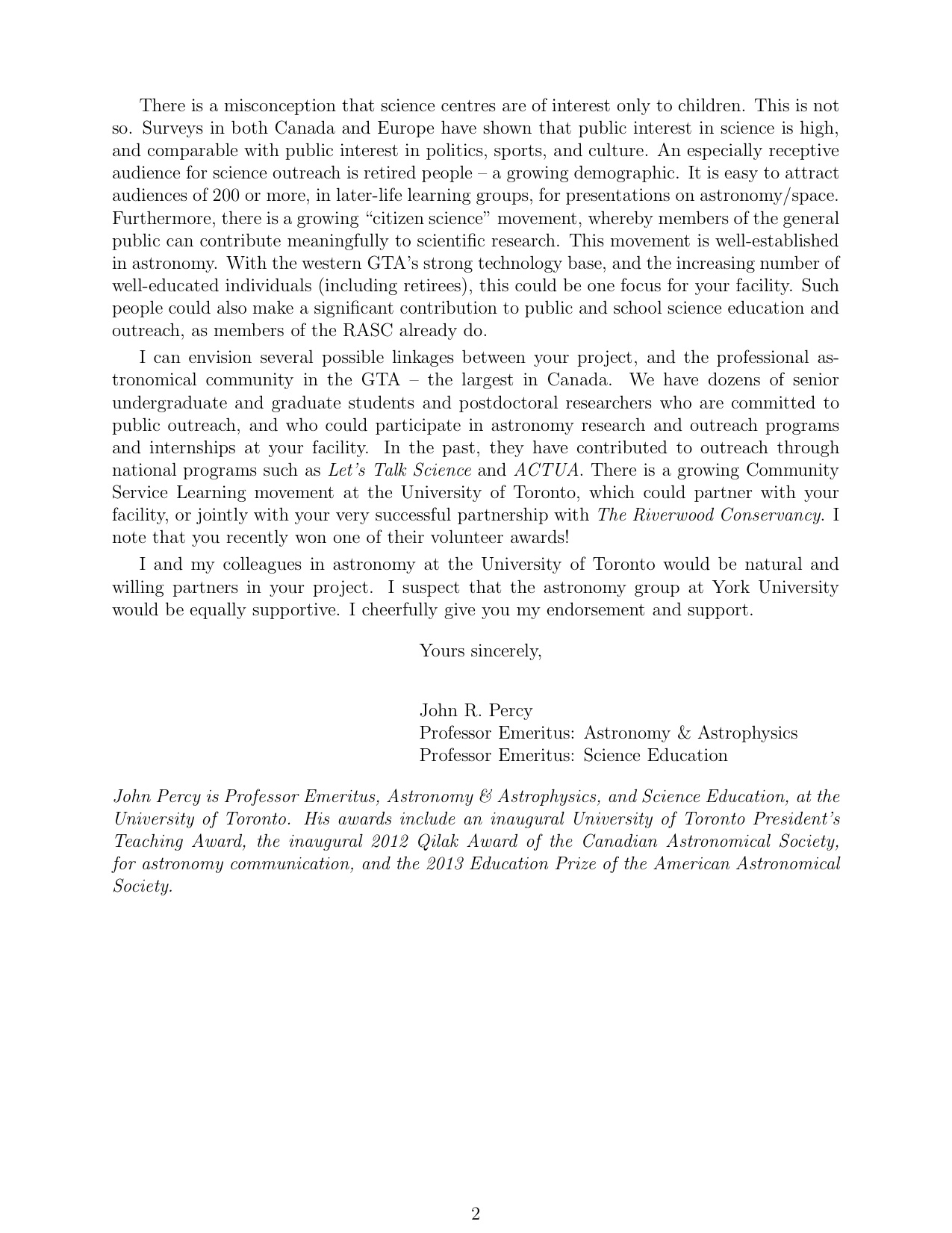Respected astronomy educator offers support for planetarium project
/
Department of
Astronomy and Astrophysics
University of Toronto
Toronto, Ontario,
Canada M5S 3H4
Professor John R. Percy
Email: john.percy©utoronto.ca
24 October, 2013
Randy Attwood
President: Earthshine Astronomy and Space Science Foundation
Dear Randy,
I'm delighted to support the Earthshine Astronomy and Space Science Foundation, and its proposal for a planetarium and astronomy/space science centre in the western GTA. I've been a professional astronomer and educator in the western GTA for 46 years (a co-founder of the University of Toronto Mississauga: UTM) and have always promoted the importance of such a facility. It would be a natural addition to the western GTA, with its population of over a million, its high-tech industry, and its other educational and cultural facilities. I have a long-standing interest in facilities of this kind — I was Vice-Chair of the Board of Trustees of the Ontario Science Centre for six years in the 1990s.
Toronto is one of the few major cities without an astronomy/space science centre. Sadly, the McLaughlin Planetarium closed in the 1990s, as an unnecessary result of uncertainty in government funding. The planetarium was actually very successful, both in terms of the quality and variety of its programming, and its large audience. And that was before astronomy/space became a compulsory topic in the elementary and secondary school science curriculum! Few schoolteachers have any background in astronomy, and astronomy teaching. An astronomy/space centre could provide the programs and resources which they desperately need. The Science Teachers Association of Ontario tells me that astronomy/space, optics, and climate change are the three topics for which teachers most often ask for professional development. Your facility could serve the needs of some of the largest school boards in Canada.
There is a large and growing public interest in astronomy and space, as we found out during International Year of Astronomy 2009, which attracted almost two million people to over 3,600 events across the country. Attendance at Canadian planetariums, and membership in public astronomy organizations such as the Royal Astronomical Society of Canada (RASC) continue to be strong. The RASC would be a natural supporting partner for your project; it was a 2003 winner of the prestigious national Michael Smith Award for outstanding contributions to science outreach.
There is a misconception that science centres are of interest only to children. This is not so. Surveys in both Canada and Europe have shown that public interest in science is high, and comparable with public interest in politics, sports, and culture. An especially receptive audience for science outreach is retired people — a growing demographic. It is easy to attract audiences of 200 or more, in later-life learning groups, for presentations on astronomy/space. Furthermore, there is a growing "citizen science" movement, whereby members of the general public can contribute meaningfully to scientific research. This movement is well-established in astronomy. With the western GTA's strong technology base, and the increasing number of well-educated individuals (including retirees), this could be one focus for your facility. Such people could also make a significant contribution to public and school science education and outreach, as members of the RASC already do.
I can envision several possible linkages between your project, and the professional astronomical community in the GTA — the largest in Canada. We have dozens of senior undergraduate and graduate students and postdoctoral researchers who are committed to public outreach, and who could participate in astronomy research and outreach programs and internships at your facility. In the past, they have contributed to outreach through national programs such as Let's Talk Science and ACTUA. There is a growing Community Service Learning movement at the University of Toronto, which could partner with your facility, or jointly with your very successful partnership with The Riverwood Conservancy. I note that you recently won one of their volunteer awards!
I and my colleagues in astronomy at the University of Toronto would be natural and willing partners in your project. I suspect that the astronomy group at York University would be equally supportive. I cheerfully give you my endorsement and support.
Yours sincerely,
John R. Percy
Professor Emeritus: Astronomy & Astrophysics Professor Emeritus: Science Education
John Percy is Professor Emeritus, Astronomy & Astrophysics, and Science Education, at the University of Toronto. His awards include an inaugural University of Toronto President's Teaching Award, the inaugural 2012 Qilak Award of the Canadian Astronomical Society, for astronomy communication, and the 2013 Education Prize of the American Astronomical Society.














